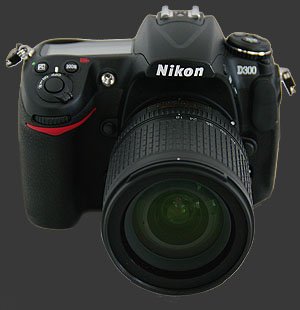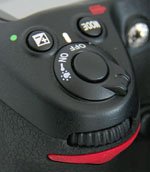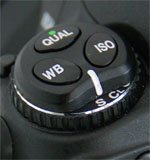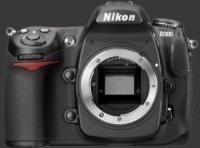Nikon D300 Review
Nikon D300 Introduction
The D300 is Nikon's most advanced non-full frame digital SLR. This is a professional grade 12 megapixels camera with high-speed continuous shooting capabilities and very sophisticated focusing and metering systems.
The Nikon D300 caters to advanced photographers by providing extensive control and customization of its interface and behavior. External lighting, including Nikon's famous speedlights, can be controlled both wired and wireless directly from the camera.
This review takes a close look at the D300's features, ergonomics, usability, image quality, performance and photographic controls. As Nikon's number two DSLR, just behind the full-frame D3, the D300 has the following major features:
- 12 Megapixels image sensor, 1.5X crop-factor.
- Automatic and selectable ISO from 100 to 6400.
- 1/8000s to 30s shutter-speeds, plus bulb mode.
- Metering modes: multi-segment, center-weighed, average and spot.
- Standard PASM full manual controls.
- Exposure compensation: -5..+5 EV in 1/2 or 1/3 EV steps.
- Exposure bracketing: 3 to 9 images, 1/2 or 1 inc.
- Standard flash modes: normal, redeye, slow, slow with redeye and rear-curtain sync.
- Automatic, preset, kelvin and custom white-balance, all fine-tunable.
- Focus modes: single-shot, continuous and manual.
- 51-point auto-focus system with 3D dynamic tracking.
- Focus-point selection: automatic, manual or dynamic in groups of 9, 21 or 51 points.
- Single shot, continuous drive mode up to 8 FPS, live-view, customizable self-timer and mirror lock-up.
- Hardware dust-reduction to reduce the need to clean the image sensor.
- Weather-seals to protect against dust and moisture.
- 3” LCD 920K Pixels.
- 100% coverage viewfinder with 0.95X magnification.
- Image review with magnification and histogram, luminance and RGB.
- Depth-of-field preview.
- Built-in flash and hot-shoe.
- Lithium-ion battery.
- Compact Flash interface with support for UDMA.

Features, continued:
- Auto-ISO with selectable maximum sensitivity and minimum shutter-speed.
- Dual-control wheels, for efficient parameter selection and navigation.
- Auto-Exposure-Lock & Auto-Focus-Lock button and Auto-Focus activation button.
- Customizable sharpness, contrast, brightness, saturation and hue.
- Multi-exposure photography mode.
- Illuminated top status panel.
- JPEG, TIFF and RAW modes. Compression and quality options for RAW.
- Live view with phase-detect or contrast-detect focus.
Nikon D300 Suitability - What is it good for?
The Nikon D300 is suitable for every type of photographic subject and is one of the most versatile DSLRs around. Combining its high-resolution sensor and high-speed continuous shooting with 3D tracking focus means that it covers photographic subjects from landscapes to action. The versatility of the Nikon D300 is further ensured by its compatibility with Nikon lenses and compatibility with Nikon's creative lighting system.
For specific photographic subjects, lens versatility is quite important. The Nikon lens lineup covers a wide variety of focal-lengths from the ultra-wide to the super telephoto. Most 3rd party manufacturers produce lenses for Nikon mounts too. With Nikon, image stabilization is provided by VR (Vibration Reduction) lenses which are available in some, mostly telephoto, lenses.
The Nikon D300 is larger and heavier than most DSLR cameras. This, plus its weather-sealed body, makes it more suitable for rougher environments. Conversely, its bulk is more noticeable and less discrete, plus there is bright yellow writing on the strap. This is somewhat a disadvantage for street and candid photography.

Nikon D300 Capability - What can it do?
As noted in the introduction, the Nikon D300 has everything expected from a DSLR with an impressive amount of customization. Headline features include a built-in dust-reduction mechanism, a weatherproof body, high-speed continuous drive, a 51-point auto focus system and multiple options for RAW image formats. High speed continuous drive can shoot at 6 FPS or less without the optional battery grip, or at 8 FPS with the grip.
 The Nikon D300's power-switch has 3 positions: Off, On and illuminate. The illuminate position is used to light up the top LCD, unless the option to have it permanently lit is enabled. The other two positions are self-explanatory but note that, even when the camera is off, the D300 shows how many images can still fit into the memory card at the currently set quality, resolution and file-format. This is great because you can tell if you have a card inserted without effort.
The Nikon D300's power-switch has 3 positions: Off, On and illuminate. The illuminate position is used to light up the top LCD, unless the option to have it permanently lit is enabled. The other two positions are self-explanatory but note that, even when the camera is off, the D300 shows how many images can still fit into the memory card at the currently set quality, resolution and file-format. This is great because you can tell if you have a card inserted without effort.
The shutter-release on this DSLR is a standard 2-stage release with a very soft halfway point. By default, pressing the shutter-release halfway locks focus and exposure. There are options to disable exposure and focus locking independently. There is a dedicated AF-ON button which can be used to lock exposure before pressing the shutter-release. There is also a combined AE-L/AF-L button which can be set to one of 13 functions, including locking exposure, locking flash metering and locking focus. AEL appears in the viewfinder whenever exposure is locked, regardless of the mechanism. This allows to confirm which behavior is active.
Exposure modes on the Nikon D300 are controlled by a modeless button. Instead of the usual mode-dial, the D300 uses a Mode button in combination with the rear command dial to select between the four ubiquitous exposure modes. These modes are: program (P), shutter-priority (S), aperture-priority (A) and full manual (M) mode. Notably absent from these mode-dial are scene modes which frequently control the camera in mysterious ways. In Manual mode, the shutter-speed selection includes a Bulb mode that keeps the shutter open as long as the shutter-release is pressed.
On the camera's rear, surrounding the AE-L/AF-L button, is the metering selection switch. While there are only three positions to this switch, the D300 has sophisticated control over metering. Matrix metering mode uses 1005 pixels to meter the entire scene. Spot metering mode uses 2% of the frame to meter for 18% gray. The center-weight metering mode uses the entire frame with 75% emphasis on the centerCustomizable between 4% and 9% using a 6mm, 8mm, 10mm or 13mm metering circle but it can be configured as average metering instead.

The Nikon D300 has detailed control over white-balance including automatic white-balance, preset white-balanceIncandescent, Fluorescent, Sunlight, Flash, Cloudy and Shade., manual white-balance and color-temperature. All white-balance options can be fine-tuned in 13-steps from blue to amber and magenta to green. Curiously, even Kelvin white-balance can be adjusted, meaning that the chosen color temperature is not necessarily accurate. Manual white-balance can be saved in one of 4 memory slots with a reference thumbnail to help remember which one is which. It seems obvious to put a thumbnail there, yet the Nikon D300 is the first camera we have seen do it. This is the kind of detail which Nikon puts in their cameras.
Exposure compensation can be adjusted in 1/2 or 1/3 EV increments using the exposure compensation button combined with the command dial. The range of exposure compensation is -5 to +5. The Nikon D300 can bracket exposure for 3, 5, 7 or 9 frames, with increments between 1/3 and 1 EV. Both the wide exposure compensation range and large bracket make the D300 a fantastic camera to form HDR images with.
This DSLR supports the standard drive modesSingle, continuous and self-timer., live-view, mirror lock-up and multiple exposure. The self-timer is customizable with possible 2s, 5s, 10s and 20s delay. Mirror lock-up requires one press of the shutter-release to raise the mirror and one to take the picture. Note that this is not ideal without a remote trigger because pressing the shutter-release can cause more vibrations than the mirror itself. Multiple-exposure can combine between 2 and 9 images with or without automatic exposure adjustment.
In continuous drive mode, the Nikon can shoot up to 100 JPEG images at 6 FPS or more. To get above 6 FPS, up to 8 FPS actually, you must use the optional battery-grip. There is a high-speed continuous drive mode which shoots at the maximum rate and a low-speed continuous shooting mode which shoots at between 1 and 7 FPS, depending on a custom-setting and, in the case of 7 FPS, whether the grip is being used or not.
 Unfortunately, since drive-mode selection is modal via a dial, drive modes cannot be reset by the camera. Other cameras usually reset their long self-timer after each use. This would avoid the common mistake of forgetting to reset the long self-timer.
Unfortunately, since drive-mode selection is modal via a dial, drive modes cannot be reset by the camera. Other cameras usually reset their long self-timer after each use. This would avoid the common mistake of forgetting to reset the long self-timer.
The Nikon D300 supports JPEG, TIFF and RAW images. JPEG images are available in 3 quality levels. TIFF files are always saved as 8-bit files which unfortunately make them only marginally better than JPEG files. Ideally, a DSLR should support losslessly compressed 16-bit TIFF files. RAW on this digital SLR is very flexible. There is the choice of uncompressed, compressed or losslessly compressed, plus the choice between 12-bit and 14-bit files. While 14-bit files are better because of higher precision, they slow down the D300's continuous shooting to a maximum of 2.5 FPS.
The image sensor is mounted on a moving plate which serves to shake off dust, reducing its accumulation. While we have not measured its efficiency, these systems are generally not 100% effective and the only remove the lightest of dust-particles. Any significantly stuck particle requires manual cleaning.
 |
Please Support Neocamera
All information on Neocamera is provided free of charge yet running this website is a huge endeavor. Purchases made via affiliate links found throughout the site help keep it running and up-to-date. There is no additional cost to you, so please consider buying via these links to our affilates:
If you found any information on this site valuable and did not purchase via our affiliate links, please considering donating via PayPal:
Any amount will be greatly appreaciated. Thank you for your support!
Nikon D300 Highlights

Sensor-Size: 24 x 16mm

Actual size when viewed at 100 DPI
| 12 Megapixels DSLR | ISO 100-6400 |
| Nikon F Mount 1.5X FLM | Shutter 1/8000-30s |
| 100% Coverage Large Viewfinder | Full manual controls, including Manual Focus |
| Weatherproof | Custom white-balance with 2 axis fine-tuning |
| Built-in Dust Reduction | Spot-Metering |
| 6 FPS Drive, 100 Images | Hot-Shoe & Sync-Port |
| 3" LCD 920K Pixels | Lithium-Ion Battery |
| Compact Flash |
Updates
2025.01.18

Fujifilm GFX 2025 Lens Roundup
Lens Review roundup of Fujifilm GFX Medium-Format lenses. Quality, performance and handling of the GF20-35mm F/4R WR, GF30mm F/3.5 Tilt-Shift and the GF55mm F/1.7.
2024.11.18

Best 2024 Photography Gifts for Every Budget
Great gifts for photographers and photo enthusiasts selected for every budget among the best products of 2024.
2024.08.07

Eye Protection Tips for Professional Photographers
The four main considerations for professional photographers regarding eyewear.
2024.07.14

Fujifilm X100VI Review
Flagship fixed-lens compact digital camera with a 40 MP sensor and Image-Stabilization, a first for the series. Retro design featuring dual control-dials, plus direct ISO, Shutter-Speed and EC dials. Its hybrid viewfinder can switch between EVF and OVF mode.
2024.05.09

Fujifilm GFX100 II Review
Flagship 102 Megapixels Medium-Format Mirrorless Digital Camera with 8-Stop 5-Axis IBIS, 8 FPS Drive, 8K Video and 400 MP Super-Resolution capture in a weatherproof and freezeproof body with dual control-dials and dual memory-card slots.
2024.04.03

Fujifilm X-T5 Review
Newest Fujifilm flagship boasting a 40 MP APS-C sensor, 5-axis IBIS with 7-stop efficiency, 15 FPS continuous drive, 6.2K Video capture, dual control-dials and dual SDXC UHS-II slots in a sturdy weatherproof and freezeproof body.
2023.11.20

Best Digital Cameras of 2023
Find out which are the Best Digital Cameras of 2023. All the new Mirrorless Digital Cameras from entry-level to high-end professional.
2023.07.10

Fujifilm X-H2 Review
40 Megapixels APS-C Hybrid Mirrorless Digital Camera with 7-stop IBIS. Fastest shutter ever and 8K video capture. Large builtin EVF with 0.8X magnification and 5.8 MP, plus an Eye-Start Sensor. Packed with features and large number of controls in a weatherproof and freezeproof body.
2023.05.07

Sony FE 20-70mm F/4G Review
Review of the unique Sony FE 20-70mm F/4G lens. The optical zoom of this lens spans ultra-wide-angle and medium focal-length coverage, making it one of the most versatile Full-Frame lenses on the market.
2023.01.15

Huion Inspiroy Dial 2 Review
Review of the Huion Inspiroy Dial 2 tablet, a medium sized drawing surface with dual dials and customizable buttons. Connects via USB-C or Bluetooth 5.0 with Windows, Linux and Android support.
2022.12.08

How to Pack for a Photo Trip
Find out how to pack for a travel photography trip, carry your gear safely while meeting airline regulations.
2022.11.13

Best Digital Cameras of 2022
The best digital cameras of 2022. A short list of the most outstanding models in their respective categories. Choose one for yourself or as a gift.










